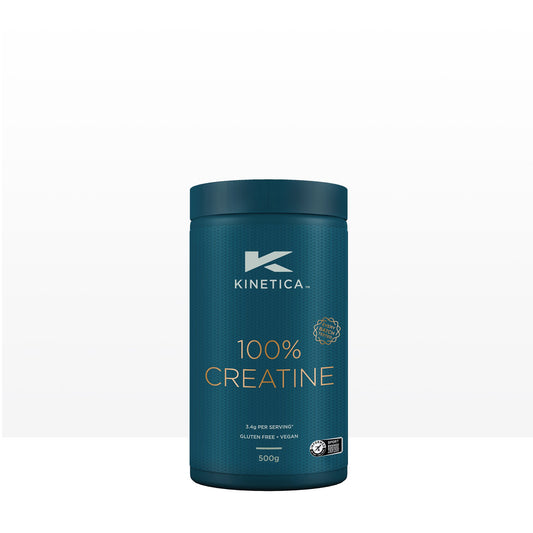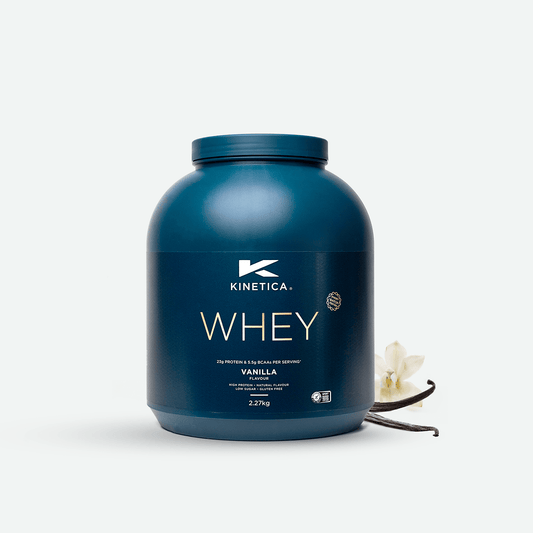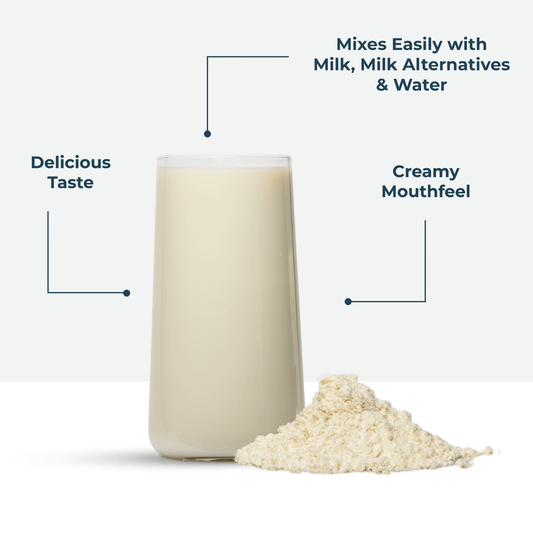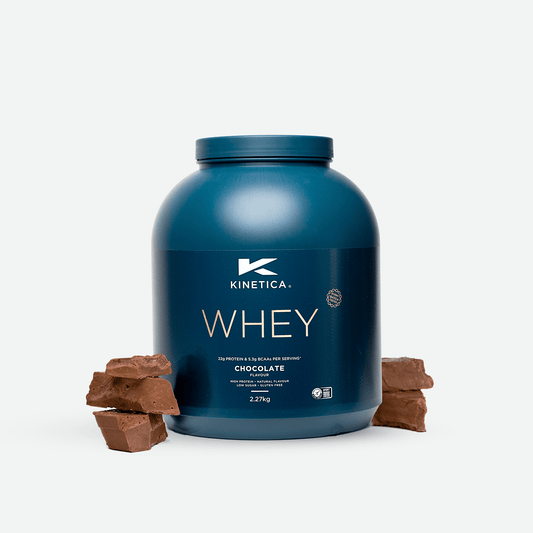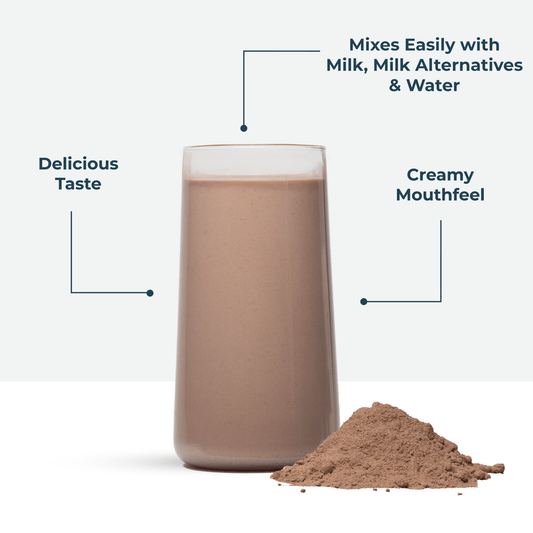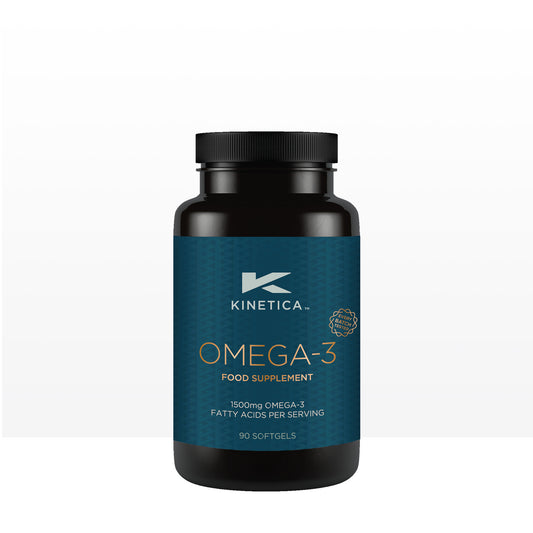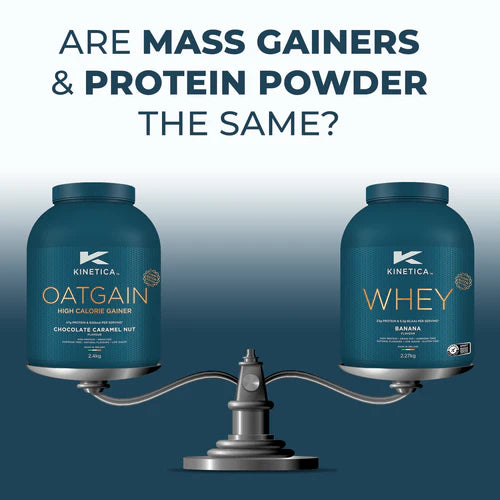What is Grass Fed Whey & Why is it Important?

What is whey protein?
How is whey protein made?
What is grass-fed whey?
Is grass-fed whey better than regular whey?
Why choose Kinetica Grass Fed Whey?
What is Whey Protein?
Whey protein is a popular dietary supplement used by athletes, fitness enthusiasts, and individuals looking to supplement their protein intake. Whey protein is a type of protein that is derived from milk. It is a complete protein, meaning that it contains all of the essential amino acids that your body needs to function properly.
There is a lot of evidence to support the use of whey protein for promoting muscle growth and recovery. Studies have shown that whey protein can help increase muscle mass, improve muscle strength, and reduce muscle damage after exercise.
Whey protein is often sold in powdered form and can be added to drinks or a variety of different meals and snacks to increase your protein intake. Some popular options include adding whey protein to smoothies, oats, yogurts, or baked goods.
How is Whey Protein Made?
Whey protein is made from the liquid that is left over after milk has been curdled and strained to make cheese. This liquid is heated and treated with enzymes to separate the whey protein from the other components of the milk. The whey protein is then filtered, dried, and turned into a powder.
There are two main types of whey protein: whey protein concentrate (WPC) and whey protein isolate (WPI). WPC contains between 70-80% protein, with the remaining portion consisting of fat and lactose, while WPI is further processed to remove almost all of the fat and lactose, resulting in a product that is at least 90% protein.
A high-quality whey protein should contain approximately 3g of leucine per serving. Leucine is viewed as a key essential amino acid for supporting muscle protein synthesis (MPS). Kinetica whey protein contains 2.47g of leucine per 30g serving and it also has 5.5g of naturally occurring Branched Chain Amino Acids.

What is Grass-Fed Whey?
Grass-fed whey protein is a type of protein supplement that is made from the milk of grass-fed cows. The cows are raised on pastures where they are allowed to graze on grass and other natural vegetation, as opposed to being fed with grain or other feed that is commonly used in conventional farming.
The whey protein is extracted from the milk through a filtration process. Grass-fed whey protein is typically low in fat and lactose, which makes it easier for individuals with lactose intolerance to digest. It can be considered to be superior to conventional whey protein because it is higher in important nutrients like omega-3 fatty acids and conjugated linoleic acid (CLA), which are found in higher amounts in grass-fed milk. It may also contain small amounts of other components, such as immunoglobulins, lactoferrin, and glycomacropeptides, which are thought to have various health benefits.

Shop Now: Whey Protein Powder
Why Choose Kinetica Whey Protein?
Kinetica whey protein is a high-quality protein blend that contains 23g of protein per 30g serving. In addition to this, their whey is sourced from grass-fed cows which means that the amino acids are naturally occurring, with nothing added. It also contains 2.47g of leucine per 30g serving which is essential for supporting muscle protein synthesis.
Kinetica’s whey protein and other products within their range are batch tested via Informed Sport. This means that there are no banned substances contained in their products which enhances their product quality and safety. To add further peace of mind, Kinetica ia a member of the European Specialist Sports Nutrition Alliance (ESSNA) to ensure their products comply with best practice. Kinetica’s Whey Protein was shortlisted as one of the best post-workout products at the ESSNA 2020 Awards which emphasises the quality of their product.
In conclusion, whey protein is a valuable supplement for promoting muscle growth and recovery. Overall, grass-fed whey protein is a high-quality and sustainable source of protein that is rich in important nutrients, and can be a valuable addition to a healthy diet and exercise routine.
About the Author
Eva is a performance Dietitian who has worked in the clinical health care setting providing nutrition support to patients with a range of different diseases. Eva is now currently working full time as a performance dietitian with daveynutrition. She is working with the Dublin Senior hurlers as well as individual athletes providing them with the education and skill set to maximise their performance and reach their potential.
Eva's passion for performance-based sports nutrition developed from her own personal experience playing Gaelic football. Eva now trains and competes in Crossfit where her own personal experiences have led her to understand the pivotal role that nutrition plays in performance enhancement, injury prevention and management, recovery from exercise and body composition. Outside of sports Eva also loves to cook and create new recipes to support her health and sports performance.
References:
1. Alothman, M., Hogan, S. A., Hennessy, D., Dillon, P., Kilcawley, K. N., O'Donovan, M., Tobin, J., Fenelon, M. A., & O'Callaghan, T. F. (2019). The "Grass-Fed" Milk Story: Understanding the Impact of Pasture Feeding on the Composition and Quality of Bovine Milk. Foods (Basel, Switzerland), 8(8), 350.
2. Blomstrand E, Eliasson J, Karlsson HK, Kohnke R. Branched-chain amino acids activate key enzymes in protein synthesis after physical exercise. J Nutr. 2006;136(1 Suppl):269s-73s.
3. Boirie Y, Dangin M, Gachon P, Vasson MP, Maubois JL, Beaufrere B. Slow and fast dietary proteins differently modulate postprandial protein accretion. Proc Natl Acad Sci U S A. 1997;94(26):14930-5.
4. Devries MC, Phillips SM. Supplemental protein in support of muscle mass and health: advantage whey. J Food Sci. 2015;80 Suppl 1:A8-a15.
5. Differences in whey protein content between cow's milk collected in late pasture and early indoor feeding season from conventional and organic farms in Poland. Beata Kuczyńska, Kamila Puppel et al., Journal of the Science of Food and Agriculture, (2012), 2899-2904, 92(14)
6. Jakubowicz D, Froy O. Biochemical and metabolic mechanisms by which dietary whey protein may combat obesity and Type 2 diabetes. J Nutr Biochem. 2013;24(1):1-5.
7. Leidy, H. J., Carnell, N. S., Mattes, R. D., & Campbell, W. W. Higher Protein Intake Preserves Lean Mass and Satiety with Weight Loss in Pre-obese and Obese Women. Obesity. 2007; 15(2): 421–429.
8. Markus CR, Olivier B, Panhuysen GE, Van Der Gugten J, Alles MS, Tuiten A, et al. The bovine protein alpha-lactalbumin increases the plasma ratio of tryptophan to the other large neutral amino acids, and in vulnerable subjects raises brain serotonin activity, reduces cortisol concentration, and improves mood under stress. Am J Clin Nutr. 2000;71(6):1536-44.
9. Paddon-Jones D, Westman E, Mattes RD, Wolfe RR, Astrup A, Westerterp-Plantenga M. Protein, weight management, and satiety. Am J Clin Nutr. 2008;87(5):1558s-61s.
10. Pal S, Ellis V. The chronic effects of whey proteins on blood pressure, vascular function, and inflammatory markers in overweight individuals. Obesity (Silver Spring). 2010;18(7):13549.
11. Schoenfeld BJ, Aragon AA, Krieger JW. The effect of protein timing on muscle strength and hypertrophy: a meta-analysis. J Int Soc Sports Nutr. 2013;10(1):53.
12. Schönfeldt C.H., Hall N.G., Smit L.E. The Need for Country Specific Composition Data on Milk. Food Res. Int. 2012;47:207–209
13. Solak, B.B. & Akin, N. Health Benefits of Whey Protein: A Review. Journal of Food Science and Engineering. 2012; 2, 129-137.
14. Willoughby DS, Stout JR, Wilborn CD. Effects of resistance training and protein plus amino acid supplementation on muscle anabolism, mass, and strength. Amino Acids. 2007;32(4):467-77.
